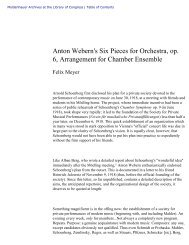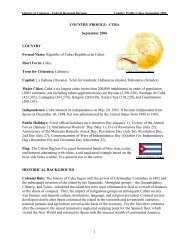1 - American Memory
1 - American Memory
1 - American Memory
You also want an ePaper? Increase the reach of your titles
YUMPU automatically turns print PDFs into web optimized ePapers that Google loves.
174<br />
THE 1949 HAWAII DOCK STRIKE<br />
The International Longshoremen's and Warehousemen's Union (ILWTJ) struck<br />
seven Hawaii stevedoring companies on May 1, 1949, when deadloclced tallts on<br />
a wage reopener could not be resolved. Jlilitary shipping was exempted by the<br />
union and special ships carrying food were also allowed to unload, but otherwise<br />
the islands' docks were effectively closed. Hawaii's Governor seized the docks<br />
under a special dock seizure law passed by an emergency session of the Terri-<br />
torial Legislature, but little traffic could be resumed. The strike ended October<br />
2.'5, 1949. and the Governor returned the dock.s to the companies following a wage<br />
agreement.<br />
THE 19B2 SAILOBS' STRIKE<br />
The Sailors Union of the Pacific struck the Pacific Maritime Association<br />
(PMA), which represents West Coast shipping companies, on May 24, 1952,<br />
after contract negotiations broke down. The settlement didn't come until July<br />
29—66 days later. This was followed by additional brief work stoppages by<br />
other shipboard unions which had been bargaining with the PMA but had waited<br />
until the Sailors' settlement.<br />
THE 1962 WEST COAST MARITIME STRIKE<br />
The three unlicensed .seamen's unions—Sailors Union of the Pacific, Marine<br />
Firemen's Union, and the Marine Cooks and Stewards Union—struck the Pacific<br />
Maritime A.ssociation on March 16,1962. They had failed to reach agreement after<br />
negotiating for seven months.<br />
The merchant fleet of 120 ships operated by member companies of the PMA<br />
was idled for 27 days until the Taft-Hartley injunction invoked by President<br />
Kennedy sent the seamen back to work. Agreements were reached during the<br />
80-day cooling-off period.<br />
THE 1966 AIRLINE STRIKE<br />
The Machinists Union struck five trunk airlines—Eastern, Northwest, Trans<br />
World, United, and National—on .Tuly 8, 1966, after lengthy negotiations failed<br />
to bring agreement. An estimated 4,100 flights and 150,000 travelers were aCfected<br />
daily by the strike. The airlines estimated their daily revenue loss at more than<br />
$7 million.<br />
United and Northwest airlines, two of the three scheduled U.S. carriers that<br />
.served Hawaii at that time, normally operated a combined total of around 15<br />
round trip flights daily between Hawaii and the Mainland, with an average<br />
combined load of 2.300 passengers. The 43-day strike, which ended on August 19,<br />
cost the Hawaiian economy some $13.5 million, including the loss of 40,000<br />
potential visitors. Hotels in Walkiki rejwrted that occupancy rates were down<br />
10 percent due to the strike. Obviously some hotels were hit harder than others,<br />
and these suffered severe financial strain. The two interisland air carriers re-<br />
ported their jiassenger load down substantially during the strike.<br />
THE 1B71 WEST COAST DOCK STRIKE<br />
The ILWU struck the Pacific Maritime Association, representing West Coast<br />
stevedoring companies, on ,Tuly 1, 1971, closing down docks all along the coasts<br />
of California. Oregon, Washington, and Alaska. Lengthy negotiations had<br />
failed to resolve disputed contract Issues, chief of which was a jurisdictlonal<br />
dispute between the ILWU and the Teamsters Union.<br />
As the strike wound up its third month, there was no progress. On October 6.<br />
1971, President Nixon intervened by invoking the Taft-Hartley Act and asking<br />
the courts for an injunction. The Injunction sent longshoremen on the West Coast<br />
hack to work on October 9 for an 80-day cooling-off jwriod. There were hardly<br />
any negotiations during the interim, however, and when the injunction expired<br />
in December, West Coast longshoremen rejected the employers' final offer and re-<br />
sumed the strike on January 17,1972, after a holiday grace period.<br />
Meanwhile, on the East Coast, the International Longshoremen's Association<br />
struck on October 1,1971, closing all Atlantic and Gulf ports until President Nixon<br />
again invoked Taft-Hartley on November 26.<br />
Agreement on the West Coa.st strike was finally reached on February 18, 1972.<br />
This agreement, which took so long to negotiate, will expire on June 30. 1973.



![Albert Einstein Papers [finding aid]. Library of Congress. [PDF ...](https://img.yumpu.com/21604228/1/190x245/albert-einstein-papers-finding-aid-library-of-congress-pdf-.jpg?quality=85)





![American Colony in Jerusalem Collection [finding aid]. Library of ...](https://img.yumpu.com/17941275/1/190x245/american-colony-in-jerusalem-collection-finding-aid-library-of-.jpg?quality=85)



![Piccard Family Papers [finding aid]. - American Memory - Library of ...](https://img.yumpu.com/17941234/1/190x245/piccard-family-papers-finding-aid-american-memory-library-of-.jpg?quality=85)


